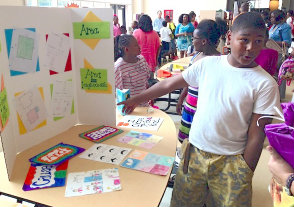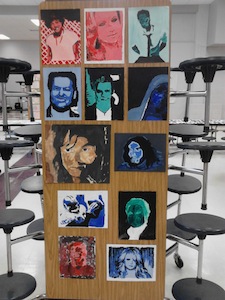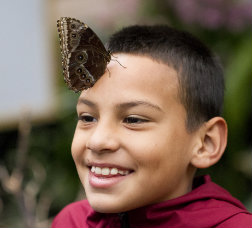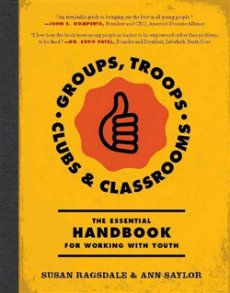Five Fun Ways to Spark Self-Discovery in Youth

In 3rd grade, I had my first experience with what research calls “sparks.” Ms. Colleen gave me the assignment of writing a story AND creating chalk illustrations. I was thrilled. The act of creating and then seeing both my artwork and my story on the walls of the hallway was phenomenal. My “spark” had been ignited.
In 4th grade, Mrs. Brown further developed my spark by challenging me to create stories from our spelling list instead of writing sentences. Then, in 6th grade, Miss Hannah asked me to read a story aloud to the class. I still recall her reaction at my climactic ending: “What? You’re not going to tell us what happens next?” I couldn’t have asked for a better response.
When I learned about Search Institute’s research on what helps youth thrive, I recalled those “sparky” moments with my teachers. I knew Search was definitely onto something.

When youth know their sparks, the research shows, they’re more likely to stay engaged in school and are well on their way to discovering their own sense of purpose. I’ve seen this big idea of “sparks” play out numerous times over the years in working with children and youth.
We all know sparky individuals
Do you know of Craig Kielburger who started Free the Children? Melissa Poe who started a non-profit for planting trees? Or Ryan and Jimmy of Ryan’s Well Foundation? Each of these individuals was young when they began to glow with their “sparky” purpose.
I’ve personally known youth who are on fire and have put their sparks to work to make the world better. I bet you have, too. I’ve observed youth leaders in 4-H who work hard to serve in the community. I’ve seen former YMCA “Bulldawgs” team members, whom I worked with from grade 3 through young adulthood, discover their sparks and become builders, educators and counselors. Today, I watch my “nieces” Miranda and Marcella who collectively are gifted in art, music and acting – I can’t wait to see what they’ll do with their gifts.


Invite youth to sit in a circle of chairs facing each other. There should be one less chair than the number of people in the group. That extra person stands in the middle and starts the game.
Ask the group to think about all the things they truly love to do or would love to try. Play begins when the circle leader says, “Take a walk if you love to . . .” and completes it by saying something he or she loves to do. (Examples might be “hike,” “travel to Italy,” or “play the drum.”) Everyone who shares that interest must scramble to find a new seat in the circle including the leader.
Participants must scramble for their new spot (but it can’t just be one chair over). The person who doesn’t find a new seat becomes the leader and calls out the next statement about what she loves.
Afterward, talk about the variety of dreams that people have and the activities that people love to do. Ask them to identify which of the activities or dreams they named that they are currently pursuing. Use the time to brainstorm and set goals for following their passions.

Instruct your group or class to rate each of the following choices you give them by making these gestures:
► If they think the choice is definitely interesting, ask them to fan their faces as if they are “hot.”
► If they think the choice is uninteresting, ask them to rub their arms as if they are freezing and need to get warm.
► If they are unsure about the choice, ask them to throw their palms up and shrug their shoulders.

- Ride a roller coaster eight times straight
- Design a building
- Put together an engine
- Make a new smoothie flavor
- Have one of my stories published
- Teach in a school in another country
- Dig in an archaeology site
- Coach an Olympic team
Afterwards, work with your group to add to the list things they would like to experience or do in their lives. Star the ones you can do with your group. Note where you can make connections between their passions and what you’re teaching in your classroom or program. How can you help them explore more?

Gather groups into two concentric circles with the inner circle facing out and the outer circle facing in – creating partners. Each pair should spend one minute total answering these questions:
- What makes you laugh out loud?
- When do you feel most alive?
- What gives you energy?
- What gets you up out of bed and excited for the day?
- What is a dream you have for your life?
- What is your day like when you get to do the thing you love most?
Debrief together:
- What did you learn about yourself from this activity?
- Did you see any themes in your answers that kept cropping up? Did you find yourself talking about the same thing over and over?

Visuals can give expression to feelings and interests that words can’t express. Music can reveal emotions and aspirations better than simple words. Poetry can capture hearts, imaginations, and minds, giving us new understanding. The arts can expand our view and help us see our experiences and the world through new eyes. Collect photos, songs, and poems to use as prompts to help youth explore purpose and passion.

Connect youth with others who share similar interests. When a person gets to talk about the very thing she loves to do with those who share that same passion, watch out!

As you seek to connect youth with others, help them realize that they are part of something much bigger than just themselves and that they can use their sparks to make the world a better place simply be being their very best selves.
Using the Activities in School and After-School
Schools can use these activities in the classroom to build stronger classroom communities, at the beginning of the year or anytime. The techniques can create stronger teacher-student relationships as each share about their “sparks.” The activities can also help students bond as they realize how much they have in common with each other.
Educators can work with students to help them discover their sparks and realize how school is a pathway to following their passions and interests. Counselors can help students formulate a purpose in life based on their sparks. Libraries can purchase books for the professional collection on appreciative learning and growth mindsets, and they can let students’ sparks help guide decision-making for classroom and school library selections.

After-school programs can use activities to help their group bond and realize common ground as well as help youth discover their sparks. They can use spark activities during program time to help guide conversations around interests and passions and connect it back to purpose.
Youth programs can expose kids to a variety of sparks through field trips, special events, activities and guest speakers. During these events, they can watch for the moments when youth really come to life, and then follow up: I noticed when we went to the botanical garden, you really seemed excited and interested when we visited the butterfly room. What was it about the butterflies?
The act of observation, commenting and asking questions to help young people think things through will help bring self-awareness. After-school programs can also involve youth in leadership of activities and in the community in service projects. The acts of leading and serving are two great methods for engaging adolescent youth who are looking for their place in their group and their world.



































Great post! Love the concept of “sparks”!